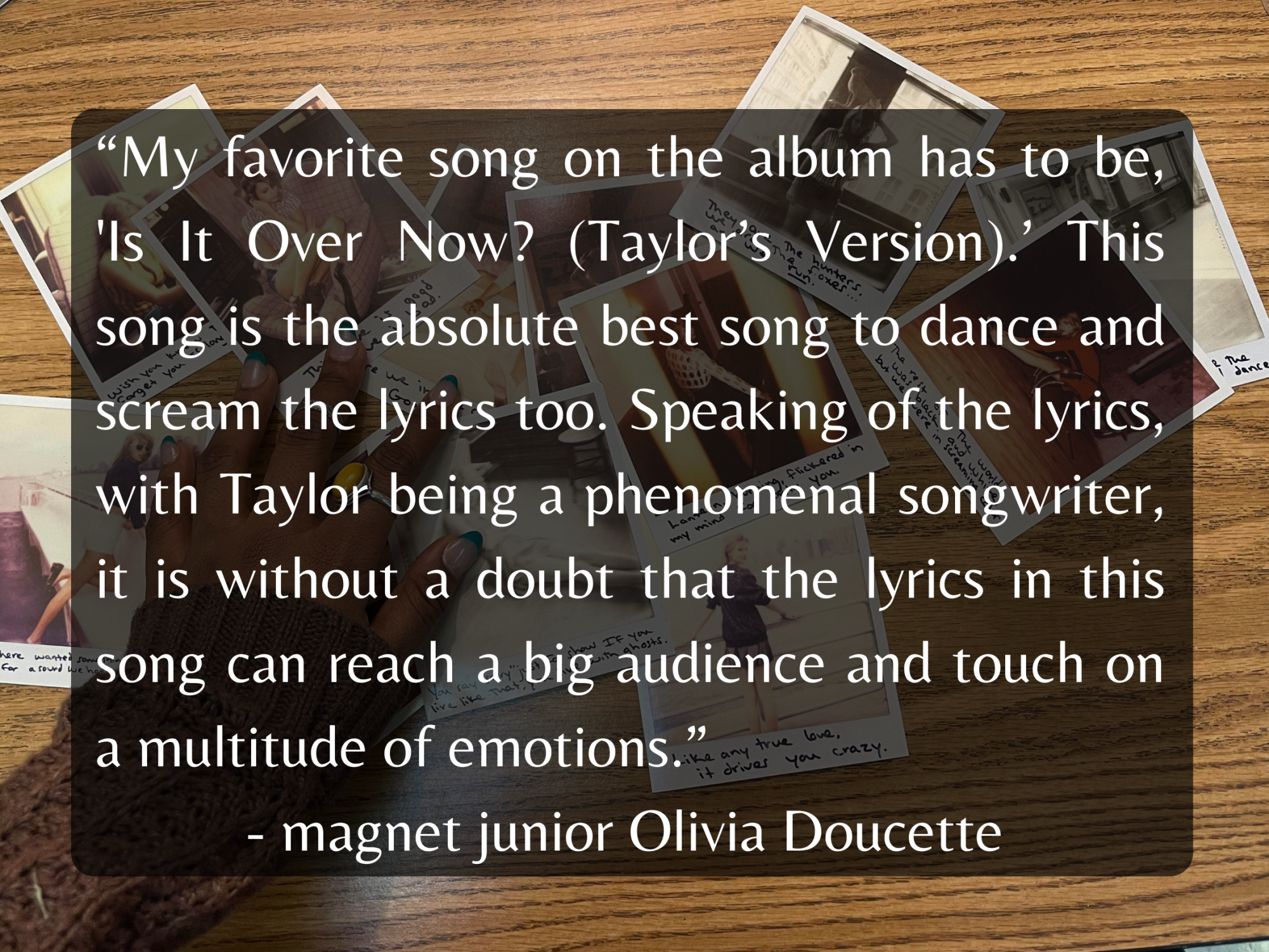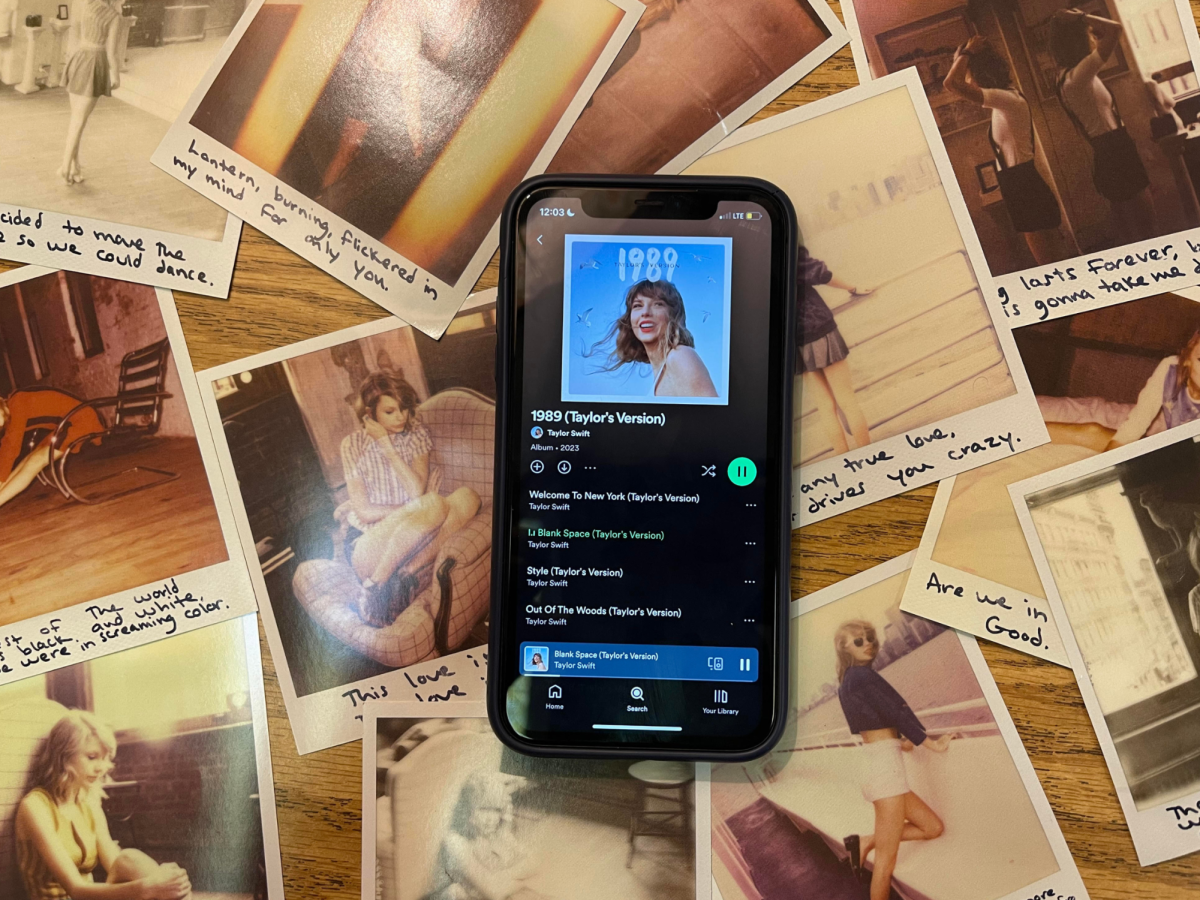To fans and critics alike, it stands as no surprise that renowned pop singer Taylor Swift has experienced nothing short of a career-defining year. With her record-breaking Eras Tour, her sweep at the 2023 MTV Video Music Awards (VMAs) and her ascent to billionaire status, the star further blossomed into her position as a cultural phenomenon. Amongst her list of recent accomplishments, she continues to re-record her first six albums of her career, finally reclaiming ownership of her own work. In 2021, she released the first of her re-recorded albums, newly labeled as “Taylor’s Version,” following the original album titles. October 27, she re-released her fifth studio album and fourth re-recording, “1989 (Taylor’s Version),” filled with emotional vocals, clearer production and a familiar charisma that transports listeners back to the original “1989” era.
The revisions of Swift’s original “1989” album on the newest “Taylor’s Version” include a multitude of tonal changes and special backtrack quirks, igniting fresh excitement among fans revisiting their favorite songs in a new form. Swift’s maturing voice features a strong, healthy resonance, changing the sound quality of each song. Over time, her vocal range has expanded, enabling her to effortlessly reach higher notes, leaving listeners astounded. Her refined enunciation provides lyrics the chance to shine and fans to develop true meanings behind each word choice.
As the classic beat of “Welcome to New York” begins, listeners instantly feel a wave of 2014 nostalgia wash over them. Swift’s immediate excitement travels through the song, as her newest rendition brings a grown-up sound to a song from her young age. 2014 pop-hit “Blank Space” introduces accompanying harmonies to the bridge, a blended tone with a high-hit, clean note. As “Style” starts, a noticeable shift in the guitar appears. The clear-sounding bass mixed with a lower, funk-sounding guitar dazes fans, known as “Swifties,” as they hear differences in such familiar songs.
This shift in the balance between the bass and melody extends its influence to other songs such as “Out of the Woods,” “Wonderland” and “New Romantics,” creating a fresh sound to each song. Additional sounds in the backtracks include laughter, harmonies and new notes, especially in the bridge of the song “I Know Places.” As Swift approaches the end of the bridge, the soaring higher notes imbue the phrase “and we run” with power and a rasp that takes center stage, adding captivating dimensions. Similarly, “How You Get the Girl” introduces a bonus squeak as she hits several of the notes, an additional eccentricity to an older song. Classic 2014 hit “Shake It Off” gained a glow-up production-wise, bringing an exciting take on a childhood song. The high riff and laughs in the background highlight Swift’s maturity and her true musical talent.
The original release of Swift’s “1989” included both an original and a deluxe version, leading Swift to do the same with “Taylor’s Version.” Because both versions of the original “1989” album were released on the same day in 2014, Swift felt inclined to release the “Taylor’s Version” albums also on the same day. “1989 (Taylor’s Version) [Deluxe]” includes “Bad Blood (feat. Kendrick Lamar) (Taylor’s Version),” her only feature in the entire album.
“I loved the album! Her vocals sound so good and clear and just knowing that it’s her own music now makes it so much more fun to listen to. I think I like it more than the original because it came out at such a good time for me to have fun with it and I understand the lyrics more at this age. Nevertheless, the original holds a special place in my heart because I went to her ‘1989’ tour and it was my first concert,” magnet junior Leika Badstibner said.
For every re-recorded album, Swift features a series of new records that she labels as “From the Vault.” The proverbial vault that lives in Swift’s musical attic stores songs that she had written at the time of the original album’s release but did not add to the final roster of songs. The vault tracks begin with “S**t!”, a melancholic love song that truly showed Swifties not to judge a track by its cover. “S**t!” conveys Swift’s acceptance of the media constantly scrutinizing her in the wake of her romantic relationships. She sings about her adoration of the man she faces ridicule for dating, and melts further into a haze of lovesick realization within the lyrics, and sings about her. The production style of the self-reflective song reminds listeners of Swift’s 2022 album, “Midnights,” completed by the heart-pounding-esque beats that linger over the background.
The second vault track, “Say Don’t Go,” holds lyrics that read as vulnerably desperate. As Swift sings of a painful breakup when she yearns for her partner to ask her to stay, the upbeat background instrumentals curate the song into a vulnerable pop hit. As the story progresses, she realizes that despite her efforts, her former lover can not provide what she begs for. Through the song, Swift questions why her former partner led her on and helplessly seeks to understand why she endured all of the hurt she had gone through. The track perfectly conveys the emptying feeling of attempting to read someone else’s mind as the listener thinks in another language and the sadness that ensues once she discovers that she could never possibly understand.
The third vault track, “Now That We Don’t Talk” sounds overwhelmingly reminiscent of the original “1989” era. The song details Swift learning about an ex’s life secondhand since they no longer speak to one another. Swift’s prolonged catharsis throughout the song represents the emerging sense of freedom a person feels post-breakup without the burden of another person’s expectations. The song has grown into a trend on TikTok, as listeners use lyrics from the song’s bridge to express feelings they have released since leaving a past relationship. Fans have speculated that the song discusses Swift’s former A-lister boyfriend, English singer Harry Styles, with several TikToks displaying different theories of Styles’ alleged affinity for “acid rock” and “mega yachts.” “Suburban Legends,” follows the spunky track, and brings listeners back to the youthful universal fantasy of falling for the boy next door. Swift reflects on the memories and regrets of young love, complete with too-nice guys and life-shattering kisses. Although the song’s runtime lies just short of three minutes, Swift utilizes every second to create nostalgia with the longingly upbeat instrumentals.
Finally, complete with hints of regret, anger and pride, “Is It Over Now?” closes, “1989 (Taylor’s Version)”. Swift sings about a past relationship that ended under potentially suspicious circumstances and asks

her former lover what truly counted as the end of their relationship. The song sounds like two exes who can not seem to let the other go, but must for the sake of closure. The song perfectly wraps up the re-recorded album as Swift powerfully stands up for herself, similarly to how she did in the ballad, “Clean,” the song that previously wrapped up the “1989” tracklist.
Fans await the next “Taylor’s Version” album announcement, creating theories on which album will come next. Recent speculation involves the release of “Reputation (Taylor’s Version)” within the next several months, continuing Swift’s long history of hidden easter eggs. The resurfacing popularity of “1989” brought a wave of childhood and teenage years to numerous Swifties. The Chant hopes “1989 (Taylor’s Version)” fulfilled all of the listener’s wildest dreams.
The Chant’s Rating: A+



















